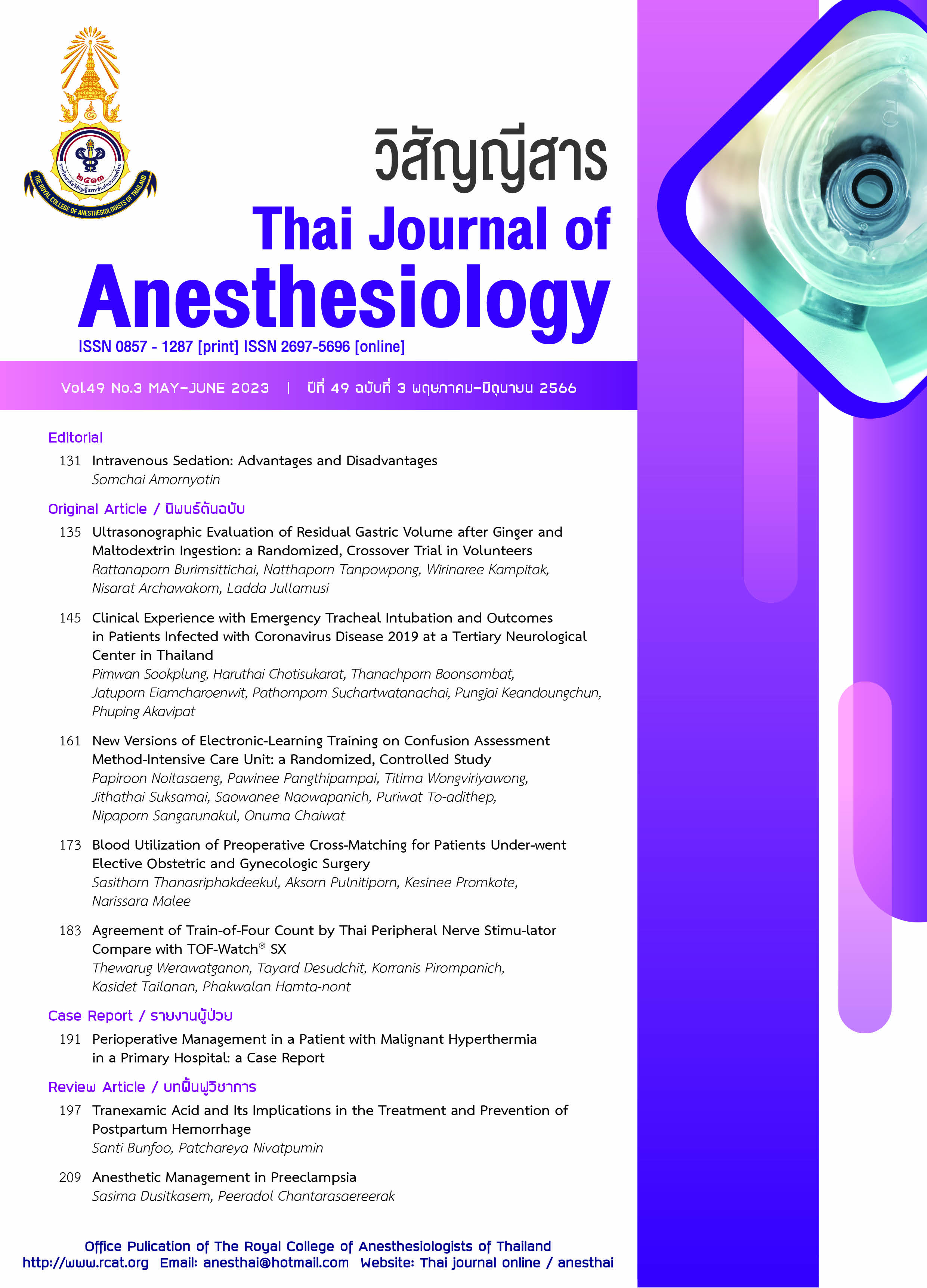Intravenous Sedation: Advantages and Disadvantages
Main Article Content
Abstract
Sedation is the reduction of irritability or agitation by administration of sedoanalgesic drugs, generally to facilitate a medical procedure or diagnostic procedure. It is explainable as a tailored method to the patient, based on anxiety level and pain aimed at achieving optimal sedation and analgesia for performing noninvasive and minimally invasive procedures. Principally, sedation is conducted in circumstances outside of the operating room such as emergency, dentistry, radiology, and gastrointestinal endoscopy.1 It is classically used for ambulatory and minor surgical procedures. In-hospital sedation in the academic center tends to be more common. The American Society of Anesthesiologists (ASA) created the guideline and definition of procedural sedation.2 Minimal (mild) sedation: Patient generally responds to the verbal command. Cardiores- piratory functions are unchanged. Minimal sedation does not invoke the monitoring requirements define in this policy. Moderate (conscious) sedation: Patient responds insistently to the verbal command or light tactile stimulation. In addition, the inter-ventions are not needed to maintain the patent airway. The cardiorespiratory functions are sufficient and also usually preserved. Deep sedation: Patient responds persistently to repeated or painful stimulation. The capacity to preserve respiratory function may be diminished. In addition, the patient may necessitate support in maintaining the airway and spontaneous respiration may be insufficient. However, the cardiovascular function is generally preserved. General anesthesia: Patient does not response to the painful stimulus. The cardio- respiratory functions are usually reduced and the patients commonly demand the support in maintaining the airway. Additionally, the positive pressure ventilations may be needed.
Article Details

This work is licensed under a Creative Commons Attribution-NonCommercial-NoDerivatives 4.0 International License.
References
Amornyotin S. Non-operating room anesthesia (NORA). Thai J Anesthesiol. 2022;48:83-5.
Practice guidelines for moderate procedural sedation and analgesia 2018. A report by the American Society of Anesthesiologists Task Force on moderate procedural sedation and analgesia, the American Association of Oral and Maxillofacial Surgeons, American College of Radiology, American Dental Association, American Society of Dentist Anesthesiologists, and Society of Interventional Radiology. Anesthesiology. 2018;128:437-79.
Amornyotin S. Monitoring for depth of anesthesia: a review. J Biomed Graph Comput. 2012;2:119-27.
Amornyotin S. Registered nurse-administered sedation for gastrointestinal endoscopic procedure. World J Gastrointest Endosc. 2015;7:769-76.
Amornyotin S, Songarj P, Kongphlay S. Deep sedation with propofol and pethidine versus moderate sedation with midazolam and fentanyl in colonoscopic procedure. J Gastroenterol Hepatol Res. 2013;2:885-90.
Patel S, Vargo JJ, Khandwala F, et al. Deep sedation occurs frequently during elective endoscopy with meperidine and midazolam. Am J Gastroenterol. 2005;100:2689-95.
Lera dos Santos ME, Maluf-Filho F, Chaves DM, et al. Deep sedation during gastrointestinal endoscopy: propofol-fentanyl and midazolam-fentanyl regimens. World J Gastroenterol. 2013;19:3439-46.
Amornyotin S, Kachintorn U, Chalayonnawin W, Kongphlay S. Propofol-based deep sedation for endoscopic retrograde cholangiopancreatography procedure in sick elderly patients in a developing country. Ther Clin Risk Manage. 2011;7:251-5.
Amornyotin S, Kongphlay S. Complication rate of propofol-based deep sedation for colonoscopy in marked obesity patients. J Gastroenterol Hepatol Res. 2015;4:1734-8.
Amornyotin S. Ketofol: a combination of ketamine and propofol. J Anesth Crit Care Open Access. 2014;1:1-6.
Amornyotin S. Sedation and monitoring for gastrointestinal endoscopy. World J Gastrointest Endosc. 2013;5:47-55.
Mason KP, Roback MG, Chrisp D, et al. Results from the adverse event sedation reporting tool: a global anthology of 7952 records derived from >160,000 procedural sedation encounters. J Clin Med. 2019;8:2087.
Amornyotin S. Intravenous sedation techniques for gastrointestinal endoscopy. J Gastroenterol Hepatol Res. 2016;5:2050-7.
Amornyotin S. Sedation-related complications in gastrointestinal endoscopy. World J Gastrointest Endosc. 2013;5:527-33.


